First All-Woman Spacewalk
First All-Woman Spacewalk
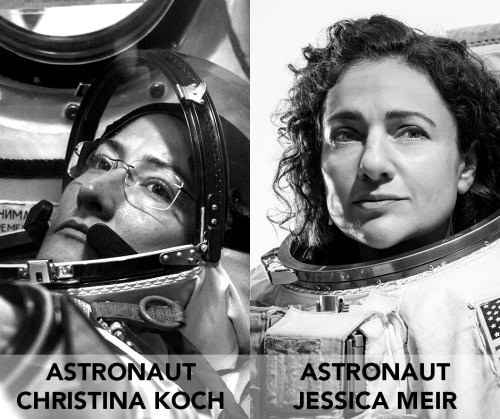
NASA astronauts and best friends, Christina Koch and Jessica Meir, made history Friday, October 18, 2019, by conducting the first all-woman spacewalk outside the International Space Station (ISS)! The Expedition 61 flight engineers ventured into the vacuum of space at 7:38 a.m. EDT to swap out a failed power controller that regulates the batteries used to collect and distribute power to the orbital laboratory – a task that took a total of seven hours and 17 minutes to complete.
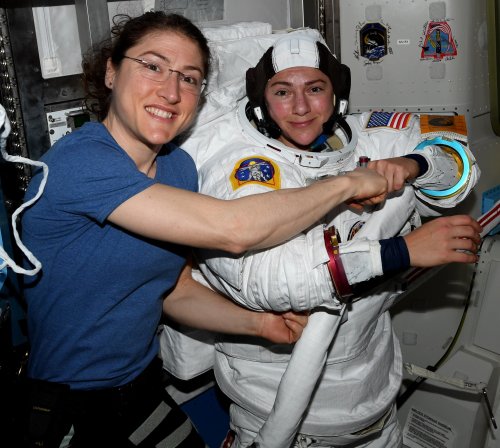
This was Koch’s fourth spacewalk and Meir’s first. Both women, selected as astronaut candidates in 2013, are on their first trip to work and live aboard the space station. Meir will be the 15th woman to spacewalk, and the 14th U.S. woman.
Get to know the astronauts
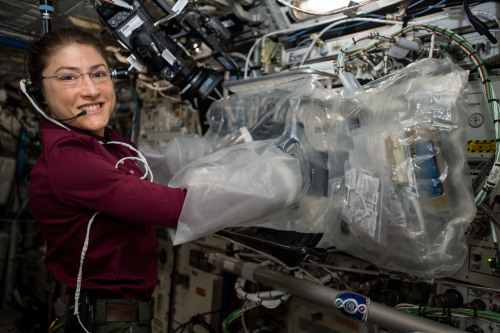
In addition to being an astronaut, Christina Koch is an engineer and physicist. Her career has taken her to extreme parts of the planet to conduct scientific field missions in places like the Antarctic South Pole and Greenland’s Summit Station. Prior to being selected as an astronaut candidate in 2013, she worked as an Electrical Engineer at our Goddard Space Flight Center’s Laboratory for High Energy Astrophysics.
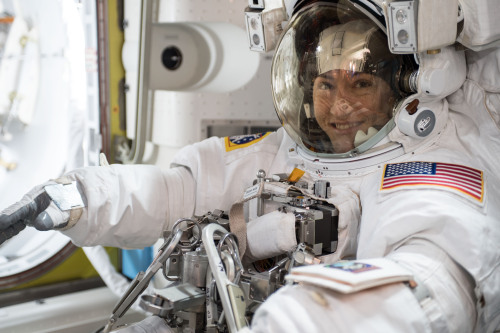
Koch left Earth on March 14, 2019, and is slated to set a record for the longest single spaceflight by a woman with an expected total of 328 days in space. Her extended mission will provide researchers the opportunity to observe the effects of long-duration spaceflight on a female body in preparation for human missions to the Moon and Mars.
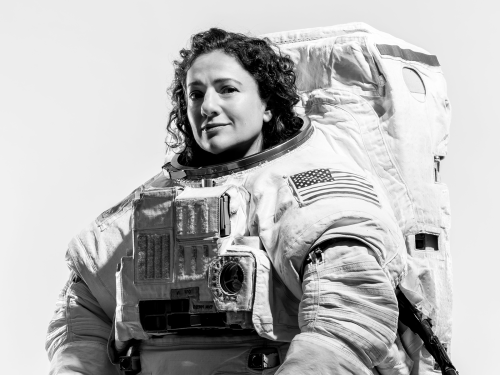
Jessica Meir dreamed of the day she would make it to space since the age of five. That dream became a reality on Wednesday, Sept. 25, 2019 as she left Earth on her first spaceflight – later floating into her new home aboard the International Space Station.
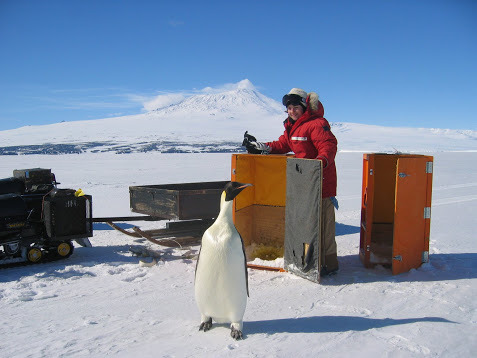
While Meir’s new home is more than 200 miles over the Earth, she is no stranger to extreme environments. She studied penguins in Antarctica and mapped caves in Italy – both of which prepared her for the ultimate extreme environment: space.
#AllWomanSpacewalk, what’s the deal?
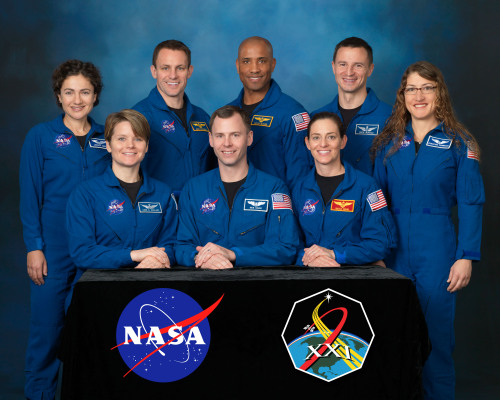
The all-woman spacewalk wasn’t something we purposefully planned; it is a testament to the increasing number of female astronauts in the space program. For example, Koch’s and Meir’s 2013 class of astronaut candidates was 50 percent women!
When asked in an interview about the importance of conducting her mission and this spacewalk, Koch said,
“In the end, I do think it’s important, and I think it’s important because of the historical nature of what we’re doing. In the past women haven’t always been at the table. It’s wonderful to be contributing to the space program at a time when all contributions are being accepted, when everyone has a role. That can lead in turn to increased chance for success. There are a lot of people who derive motivation from inspiring stories of people who look like them, and I think it’s an important story to tell.”
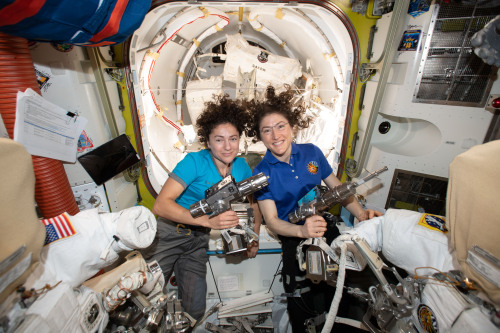
It’s important to note that spacewalks are not easy; astronauts typically describe them as the most physically challenging thing they do. Assignments are made on the basis of which astronauts are the best prepared to accomplish the tasks at hand under the conditions at the time. Today, Koch and Meir were the top astronauts for the job.
Women are no stranger to spacewalks!

While this was the first spacewalk to be conducted entirely by women, women are no strangers to spacewalks. Exactly 35 years and one week ago, Kathryn Sullivan (pictured above) made her own historic debut as the first U.S. woman to conduct a spacewalk. Since then, a total of 14 women (15 including Jessica) have ventured into the vacuum of space on 40 different spacewalks. Former Astronaut Peggy Whitson performed a record number of 10! From Astronauts to mission directors, women have been making their mark at the agency for decades now. A few of our recent pioneers are:
Astronaut Kate Rubins: First person to sequence DNA in space
Astronaut Peggy Whitson: First woman to command the ISS
Sandra Cauffman: Director of our Earth Science’s Division
Nicola Fox: Director of our Heliophysics Division
Lori Glaze: Director of our Planetary Science Division
Coming soon: The first woman to walk on the Moon
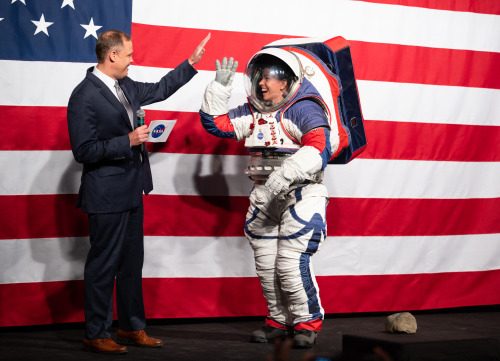
The first all-woman spacewalk is a milestone worth noting and celebrating as we look forward to putting the first woman and the next man on the Moon by 2024 with our Artemis lunar exploration program. With today’s historic event, we once again set a precedence for women to lead in space exploration.
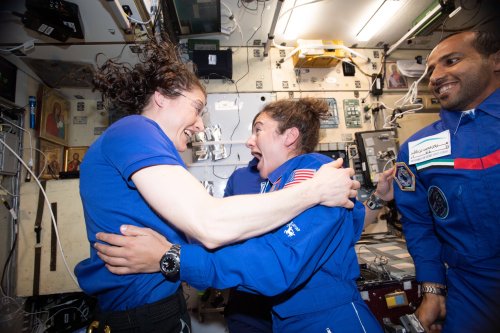
We hope achievements such as this provide inspiration to you all around the world, proving that hard work can lead you to great heights. This is not just a historic day for NASA, but a moment we can all feel proud of.
Didn’t have time to tune in? Check out the replay, here. Koch was wearing the spacesuit with red stripes, while Meir’s had no stripes.
If you’d like to keep up with Christian Koch and Jessica Meir’s work 254 miles above planet Earth, follow them on Twitter at @Astro_ Christina and @Astro_Jessica.
Be sure to follow us on Tumblr for your regular dose of space: http://nasa.tumblr.com
More Posts from Nasa and Others
Dangling in a previously unexplored lava tunnel on the Moon...
...with a massive solar flare passing overhead...
...causing unsafe radiation levels.
All communications have been interrupted.
Status of Commander Callie Rodriguez: unknown.
In our first issue of "First Woman," we followed Callie on her trailblazing journey to the Moon. Find out what’s next for our fictional first woman in a story inspired by real NASA astronauts and our upcoming Artemis missions to land the first female astronaut and person of color on the lunar surface.
See what discoveries – and challenges – lay ahead for Callie and her fellow human and robotic explorers as they forge a path to expand humanity's understanding of the universe.
Coming soon in English and Spanish at nasa.gov/calliefirst!
Make sure to follow us on Tumblr for your regular dose of space!
The Abyss of Time

Scotland is part of the bedrock of geology, so to speak.
In the late 18th century, Scottish farmer and scientist James Hutton helped found the science of geology. Observing how wind and water weathered rocks and deposited layers of soil at his farm in Berwickshire, Hutton made a conceptual leap into a deeper and expansive view of time. After spending decades observing the processes of erosion and sedimentation, and traveling the Scottish countryside in search of fossils, stream cuts and interesting rock formations, Hutton became convinced that Earth had to be much older than 6,000 years, the common belief in Western civilization at the time.
In 1788, a boat trip to Siccar Point, a rocky promontory in Berwickshire, helped crystallize Hutton’s view. The Operational Land Imager (OLI) on Landsat 8 acquired this image of the area on June 4, 2018, top. A closer view of Siccar Point is below.

At Siccar Point, Hutton was confronted with the juxtaposition of two starkly different types of rock—a gently sloping bed of young red sandstone that was over a near vertical slab of older graywacke that had clearly undergone intensive heating, uplift, buckling, and folding. Hutton argued to his two companions on the boat that the only way to get the two rock formations jammed up against one another at such an odd angle was that an enormous amount of time must have elapsed between when they had been deposited at the bottom of the ocean.
He was right.
Read more: https://go.nasa.gov/2OBnyJ8
Make sure to follow us on Tumblr for your regular dose of space: http://nasa.tumblr.com.
What is some advice that really helped you get to where you are now?

We are going to the Moon!
At 1:47 a.m. EST on Nov. 16, 2022, our Orion spacecraft launched aboard the Space Launch System (SLS) rocket from historic Launch Complex 39B at NASA’s Kennedy Space Center in Florida on a path to the Moon, officially beginning the Artemis I mission.
This mission is the first integrated test of NASA’s deep space exploration systems: the Orion spacecraft, the SLS rocket, and Kennedy ground systems. This is the very first time this rocket and spacecraft have flown together, and it’s the first of many Artemis missions to the Moon. Artemis I is uncrewed, but it lays the groundwork for increasingly complex missions that will land humans on the lunar surface, including the first woman and the first person of color to do so.
With Artemis, we will build a long-term human presence on the Moon and prepare humanity for future exploration plans to Mars and beyond.
See more photos of Artemis I on our Flickr.
Make sure to follow us on Tumblr for your regular dose of space!
Solar System: Be in the Know This Week
Our solar system is huge, let us break it down for you. Here are a few things to know this week:
1. Say Farewell to a Comet Rider

After a successful and eventful adventure landing on a comet, no more signals will be received from the Rosetta mission's comet lander, Philae.
Send your goodbyes to Philae
2. Target Shooting

Using new software our very own Mars rover Curiosity can even choose its own rock targets for its laser spectrometer.
Find out how Curiosity selects its own targets
3. Flares for the Dramatic

Our sun recently emitted three mid-size solar flares, and the Solar Dynamics Observatory captured it all.
Watch the Show!
4. Bring the Heat

Jupiter's Great Red Spot may be the mysterious heat source behind the planet’s surprisingly high upper atmospheric temperatures. When Juno begins its science orbits, the Great Red Spot will be among its top targets.
Learn More
5. Cut and Dried

The gullies on today’s Red Planet were not cut by flowing liquid water, as previously thought, but rather by processes such as the freeze and thaw of carbon dioxide frost. New findings using data from our Mars Reconnaissance Orbiter provide a new picture of the cause,
Learn More
Discover the full list of 10 things to know about our solar system this week HERE.
Make sure to follow us on Tumblr for your regular dose of space: http://nasa.tumblr.com
NASA’s 60th Anniversary: Humans in Space
It is part of the human spirit to explore. During 60 years, we have selected 350 people as astronauts to lead the way. For nearly two decades, humans have been living and working aboard the International Space Station in low-Earth orbit to enable future missions forward to the Moon and on to Mars while also leading discoveries that improve life on Earth. Since we opened for business on Oct. 1, 1958, our history tells a story of exploration, innovation and discoveries. The next 60 years, that story continues. Learn more: https://www.nasa.gov/60
Make sure to follow us on Tumblr for your regular dose of space: http://nasa.tumblr.com.
The Shrinking Aral Sea
The Aral Sea was once the fourth-largest lake in the world. Fed primarily by snowmelt and precipitation flowing down from faraway mountains, it was a temperate oasis in an arid region. But in the 1960s, the Soviet Union diverted two major rivers to irrigate farmland, cutting off the inland sea from its source. As the Aral Sea dried up, fisheries collapsed, as did the communities that depended on them. The remaining water supply became increasingly salty and polluted with runoff from agricultural plots. Loss of the Aral Sea's water influenced regional climate, making the winters even colder and the summers much hotter.

While seasonal rains still bring water to the Aral Sea, the lake is roughly one-tenth of its original size. These satellite images show how the Aral Sea and its surrounding landscape has changed over the past few decades.
For more details about these images, read the full stories here: https://go.nasa.gov/2PqJ1ot
Make sure to follow us on Tumblr for your regular dose of space: http://nasa.tumblr.com
Astronaut Journal Entry - Unusual Attitude Recovery
Currently, six humans are living and working on the International Space Station, which orbits 250 miles above our planet at 17,500mph. Below you will find a real journal entry, written in space, by NASA astronaut Scott Tingle.
To read more entires from this series, visit our Space Blogs on Tumblr.

While flying fast-moving jets, we practice the art of recovering from unusual attitudes. We close our eyes, and let the instructor put the jet in an unexpected attitude. Sometimes straight up, sometimes straight down, sometimes upside down, and sometimes anything in-between. The goal is to open our eyes, analyze the situation and make rapid and smooth corrections to power and attitude to effect a speedy recovery to straight and level flight without departing controlled flight, or having to endure high G’s, or experiencing big losses of altitude.

Sometimes, when I crawl into my crew quarters on the space station, it is very dark – just like closing our eyes in the jet. And then, as I sleep, my body floats around and changes position. When I awake in total darkness, I have to figure out what attitude I am in relative to my crew quarters and then right myself. “Unusual Attitude Recovery” can be pretty funny. And sometimes, my heart can get pumping as I awake and realize I don’t know what my attitude is. I execute my procedures to figure out what my attitude is, and then correct it. At first, it used to take me a while to realize. But now, it is second nature – and it always brings a smile to my face.
Find more ‘Captain’s Log’ entries HERE.
Follow NASA astronaut Scott Tingle on Instagram and Twitter.
Make sure to follow us on Tumblr for your regular dose of space: http://nasa.tumblr.com.
Getting to Mars: 4 Things We’re Doing Now
We’re working hard to send humans to Mars in the 2030s. Here are just a few of the things we’re doing now that are helping us prepare for the journey:
1. Research on the International Space Station

The International Space Station is the only microgravity platform for the long-term testing of new life support and crew health systems, advanced habitat modules and other technologies needed to decrease reliance on Earth.

When future explorers travel to the Red Planet, they will need to be able to grow plants for food, atmosphere recycling and physiological benefits. The Veggie experiment on space station is validating this technology right now! Astronauts have grown lettuce and Zinnia flowers in space so far.

The space station is also a perfect place to study the impacts of microgravity on the human body. One of the biggest hurdles of getting to Mars in ensuring that humans are “go” for a long-duration mission. Making sure that crew members will maintain their health and full capabilities for the duration of a Mars mission and after their return to Earth is extremely important.

Scientists have solid data about how bodies respond to living in microgravity for six months, but significant data beyond that timeframe had not been collected…until now! Former astronaut Scott Kelly recently completed his Year in Space mission, where he spent a year aboard the space station to learn the impacts of microgravity on the human body.
A mission to Mars will likely last about three years, about half the time coming and going to Mars and about half the time on the Red Planet. We need to understand how human systems like vision and bone health are affected and what countermeasures can be taken to reduce or mitigate risks to crew members.
2. Utilizing Rovers & Tech to Gather Data

Through our robotic missions, we have already been on and around Mars for 40 years! Before we send humans to the Red Planet, it’s important that we have a thorough understanding of the Martian environment. Our landers and rovers are paving the way for human exploration. For example, the Mars Reconnaissance Orbiter has helped us map the surface of Mars, which will be critical in selecting a future human landing site on the planet.

Our Mars 2020 rover will look for signs of past life, collect samples for possible future return to Earth and demonstrate technology for future human exploration of the Red Planet. These include testing a method for producing oxygen from the Martian atmosphere, identifying other resources (such as subsurface water), improving landing techniques and characterizing weather, dust and other potential environmental conditions that could affect future astronauts living and working on Mars.

We’re also developing a first-ever robotic mission to visit a large near-Earth asteroid, collect a multi-ton boulder from its surface and redirect it into a stable orbit around the moon. Once it’s there, astronauts will explore it and return with samples in the 2020s. This Asteroid Redirect Mission (ARM) is part of our plan to advance new technologies and spaceflight experience needed for a human mission to the Martian system in the 2030s.
3. Building the Ride
Okay, so we’ve talked about how we’re preparing for a journey to Mars…but what about the ride? Our Space Launch System, or SLS, is an advanced launch vehicle that will help us explore beyond Earth’s orbit into deep space. SLS will be the world’s most powerful rocket and will launch astronauts in our Orion spacecraft on missions to an asteroid and eventually to Mars.

In the rocket's initial configuration it will be able to take 154,000 pounds of payload to space, which is equivalent to 12 fully grown elephants! It will be taller than the Statue of Liberty and it’s liftoff weight will be comparable to 8 fully-loaded 747 jets. At liftoff, it will have 8.8 million pounds of thrust, which is more than 31 times the total thrust of a 747 jet. One more fun fact for you…it will produce horsepower equivalent to 160,000 Corvette engines!

Sitting atop the SLS rocket will be our Orion spacecraft. Orion will be the safest most advanced spacecraft ever built, and will be flexible and capable enough to carry humans to a variety of destinations. Orion will serve as the exploration vehicle that will carry the crew to space, provide emergency abort capability, sustain the crew during space travel and provide safe re-entry from deep space return velocities.
4. Making it Sustainable
When humans get to Mars, where will they live? Where will they work? These are questions we’ve already thought about and are working toward solving. Six partners were recently selected to develop ground prototypes and/or conduct concept studies for deep space habitats.

These NextSTEP habitats will focus on creating prototypes of deep space habitats where humans can live and work independently for months or years at a time, without cargo supply deliveries from Earth.

Another way that we are studying habitats for space is on the space station. In June, the first human-rated expandable module deployed in space was used. The Bigelow Expandable Activity Module (BEAM) is a technology demonstration to investigate the potential challenges and benefits of expandable habitats for deep space exploration and commercial low-Earth orbit applications.
Our journey to Mars requires preparation and research in many areas. The powerful new Space Launch System rocket and the Orion spacecraft will travel into deep space, building on our decades of robotic Mars explorations, lessons learned on the International Space Station and groundbreaking new technologies.
Make sure to follow us on Tumblr for your regular dose of space: http://nasa.tumblr.com

Glittering Frisbee Galaxy: This image from Hubble's shows a section of a spiral galaxy located about 50 million light-years from Earth. We tend to think of spiral galaxies as massive and roughly circular celestial bodies, so this glittering oval does not immediately appear to fit the visual bill. What's going on? Imagine a spiral galaxy as a circular frisbee spinning gently in space. When we see it face on, our observations reveal a spectacular amount of detail and structure. However, the galaxy frisbee is very nearly edge-on with respect to Earth, giving it an appearance that is more oval than circular. The spiral arms, which curve out from the galaxy's dense core, can just about be seen. Although spiral galaxies might appear static with their picturesque shapes frozen in space, this is very far from the truth. The stars in these dramatic spiral configurations are constantly moving as they orbit around the galaxy's core, with those on the inside making the orbit faster than those sitting further out. This makes the formation and continued existence of a spiral galaxy's arms something of a cosmic puzzle, because the arms wrapped around the spinning core should become wound tighter and tighter as time goes on - but this is not what we see. This is known as the winding problem. Image credit: ESA/Hubble & NASA For more information on this image, visit: https://go.nasa.gov/2niODGL
-
 ohmyjacksn reblogged this · 6 months ago
ohmyjacksn reblogged this · 6 months ago -
 hanpebicrupi liked this · 1 year ago
hanpebicrupi liked this · 1 year ago -
 dainowiter liked this · 1 year ago
dainowiter liked this · 1 year ago -
 jebatheavocado liked this · 1 year ago
jebatheavocado liked this · 1 year ago -
 aeternalswirlingfight reblogged this · 2 years ago
aeternalswirlingfight reblogged this · 2 years ago -
 revengeance102 liked this · 2 years ago
revengeance102 liked this · 2 years ago -
 missioneve liked this · 3 years ago
missioneve liked this · 3 years ago -
 cabin6halfblood reblogged this · 3 years ago
cabin6halfblood reblogged this · 3 years ago -
 obliquecompendium reblogged this · 3 years ago
obliquecompendium reblogged this · 3 years ago -
 thesunflowermartini liked this · 3 years ago
thesunflowermartini liked this · 3 years ago -
 tesssie liked this · 3 years ago
tesssie liked this · 3 years ago -
 justanotherhuman00 liked this · 3 years ago
justanotherhuman00 liked this · 3 years ago -
 dalliantize liked this · 3 years ago
dalliantize liked this · 3 years ago -
 halfbloodliz liked this · 3 years ago
halfbloodliz liked this · 3 years ago -
 23orbitz liked this · 4 years ago
23orbitz liked this · 4 years ago -
 vacant--body liked this · 4 years ago
vacant--body liked this · 4 years ago -
 ahhfucke liked this · 4 years ago
ahhfucke liked this · 4 years ago -
 milky-the-milk-carton liked this · 4 years ago
milky-the-milk-carton liked this · 4 years ago -
 steffi-one-fairy liked this · 4 years ago
steffi-one-fairy liked this · 4 years ago -
 karameki liked this · 4 years ago
karameki liked this · 4 years ago
Explore the universe and discover our home planet with the official NASA Tumblr account
1K posts